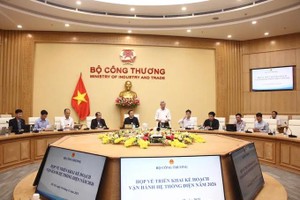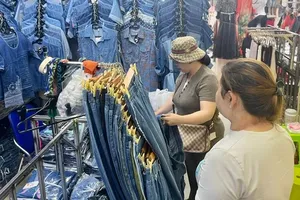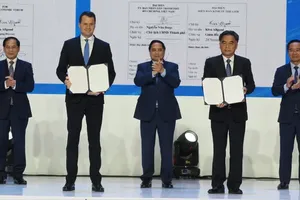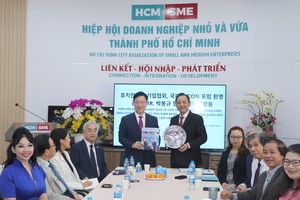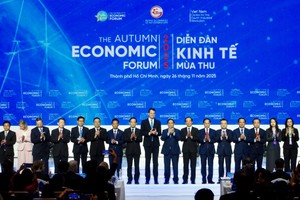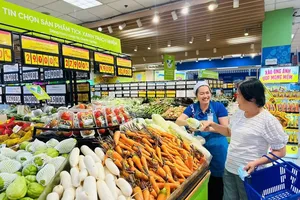
According to the report of the country's industrial production and trade in the first six months of this year, the consumption index of the manufacturing industry in June this year increased by 8.1 percent compared to the previous month and 3 percent over the same period last year.
In the first six months of the year, this index edged up by 4.3 percent over the same period last year, of which some sectors saw a strong increase in the consumption index, such as coke production, refined petroleum products with an increase of 14.7 percent; paper and paper product production with an increase of 12.1 percent; textiles with an increase of 7.3 percent; chemicals and chemical product production with an increase of 7 percent; cigarette production with an increase of 6.8 percent.
The industries posted low increases or even decreased in the consumption index were precast metal product production with an increase of 0.8 percent; food production and processing with a decrease of 0.2 percent; production of leather and related products with a decrease of 0.6 percent; metal production with a decrease of 1.4 percent; production of rubber and plastic products with a decrease of 2.5 percent; garments with a decrease of 7.2 percent; electrical equipment production with a decrease of 7.4 percent; beverage production with a decrease of 10.7 percent; production of electronic products, computers, and optical products with a decrease of 7 percent; engine-driven vehicle production with a decrease of 24.4 percent.
However, the MoIT also said that the inventory index of the processing and manufacturing industry in June surged by 26.7 percent compared to the same period last year.
Of which, some industries got a high increase in the inventory index compared to the same period last year. Manufacturing of electronic products, computers, and optical products skyrocketed by 156.2 percent; engine-driven vehicle manufacturing jumped by 129.6 percent; production of coke and refined petroleum products soared by 61.9 percent; manufacturing of precast metal products advanced by 39.5 percent; garments mounted by 39.4 percent; rubber and plastic products climbed by 38.9 percent; production of chemicals and chemical products rose by 38.4 percent; metal production emerged by 35.7 percent; cigarette production added up by 33.7 percent; food processing and manufacturing augmented by 29.4 percent; textiles increased by 28.1 percent.
The average inventory rate of the processing and manufacturing industry in the first six months of this year was quite high with 78.9 percent. In which, some industries had high inventory rate, such as textiles with 118.7 percent; wood, and wood and bamboo product processing and producing industry with 104.7 percent; the production of chemicals and chemical products with 103.4 percent; engine-driven vehicle manufacturing with 97.3 percent; the manufacturing of non-metallic mineral products with 96.5 percent; food processing and manufacturing with 96 percent.
To solve difficulties for business activities, and promote economic growth in the last six months of this year, the MoIT said that it will boost exports, improve the efficiency of trade promotion, diversify the import and export markets, and find new markets; actively exploit opportunities of free trade agreements (FTAs); prepare necessary conditions, proactively implement plans and solutions to export goods to the EU market after the EVFTA becomes effective. It will also research and grasp information about the trends of production, consumption, trade, and new investment shifting due to the impacts of the Covid-19 pandemic at importing countries, as well as competitors to put forward solutions to exploit effectively import-export markets.
Moreover, it will carry out various ways to promote trade, especially the application of online tools to maintain the market and the trade connection between Vietnamese enterprises and import partners at the markets that will possibly recover shortly, namely China, Taiwan (China), South Korea, and Japan, and gradually expand to other markets upon the developments of the pandemic.
As for production, it will accelerate the progress of key industrial projects to contribute to the overall growth of the economy. It will collaborate with the Committee for State Capital Management at Enterprises and related departments to focus on removing obstacles within their competence to speed up the progress of projects in the power industry, especially the urgent key projects to solve problems for projects, such as Long Phu 1, Song Hau 1, Thai Binh 2; at the same time, resolutely handling the projects that were implemented slowly and stagnantly, affecting the electricity supply.
It will coordinate with provinces to strongly develop production areas, industrial parks, and economic zones to be more proactive in the supply of domestic raw materials in the country; propose policies to give appropriate incentives, firstly for the textiles, footwear, and industries that were heavily affected by the Covid-19 pandemic; have mechanisms to encourage the domestic production of components and intermediaries to replace imports; closely cooperate with some multinational foreign direct investment enterprises, such as Samsung, and Toyota, increase searching for domestic enterprises capable of manufacturing raw materials and components to replace imports in the short term, as well as the long term that initially, has achieved some positive results.
It will promote restructuring in the field of industrial production. Of which, the focus is on supporting industries and from now on, it is necessary to focus on restructuring the supply chains to serve industrial production, especially some manufacturing and processing industries, such as textile and garment, footwear, electronics, and wooden furniture, in a more sustainable direction with some partners, including Korea, Japan, and India, avoiding depending too much on one or a few partners or markets.
In the first six months of the year, this index edged up by 4.3 percent over the same period last year, of which some sectors saw a strong increase in the consumption index, such as coke production, refined petroleum products with an increase of 14.7 percent; paper and paper product production with an increase of 12.1 percent; textiles with an increase of 7.3 percent; chemicals and chemical product production with an increase of 7 percent; cigarette production with an increase of 6.8 percent.
The industries posted low increases or even decreased in the consumption index were precast metal product production with an increase of 0.8 percent; food production and processing with a decrease of 0.2 percent; production of leather and related products with a decrease of 0.6 percent; metal production with a decrease of 1.4 percent; production of rubber and plastic products with a decrease of 2.5 percent; garments with a decrease of 7.2 percent; electrical equipment production with a decrease of 7.4 percent; beverage production with a decrease of 10.7 percent; production of electronic products, computers, and optical products with a decrease of 7 percent; engine-driven vehicle production with a decrease of 24.4 percent.
However, the MoIT also said that the inventory index of the processing and manufacturing industry in June surged by 26.7 percent compared to the same period last year.
Of which, some industries got a high increase in the inventory index compared to the same period last year. Manufacturing of electronic products, computers, and optical products skyrocketed by 156.2 percent; engine-driven vehicle manufacturing jumped by 129.6 percent; production of coke and refined petroleum products soared by 61.9 percent; manufacturing of precast metal products advanced by 39.5 percent; garments mounted by 39.4 percent; rubber and plastic products climbed by 38.9 percent; production of chemicals and chemical products rose by 38.4 percent; metal production emerged by 35.7 percent; cigarette production added up by 33.7 percent; food processing and manufacturing augmented by 29.4 percent; textiles increased by 28.1 percent.
The average inventory rate of the processing and manufacturing industry in the first six months of this year was quite high with 78.9 percent. In which, some industries had high inventory rate, such as textiles with 118.7 percent; wood, and wood and bamboo product processing and producing industry with 104.7 percent; the production of chemicals and chemical products with 103.4 percent; engine-driven vehicle manufacturing with 97.3 percent; the manufacturing of non-metallic mineral products with 96.5 percent; food processing and manufacturing with 96 percent.
To solve difficulties for business activities, and promote economic growth in the last six months of this year, the MoIT said that it will boost exports, improve the efficiency of trade promotion, diversify the import and export markets, and find new markets; actively exploit opportunities of free trade agreements (FTAs); prepare necessary conditions, proactively implement plans and solutions to export goods to the EU market after the EVFTA becomes effective. It will also research and grasp information about the trends of production, consumption, trade, and new investment shifting due to the impacts of the Covid-19 pandemic at importing countries, as well as competitors to put forward solutions to exploit effectively import-export markets.
Moreover, it will carry out various ways to promote trade, especially the application of online tools to maintain the market and the trade connection between Vietnamese enterprises and import partners at the markets that will possibly recover shortly, namely China, Taiwan (China), South Korea, and Japan, and gradually expand to other markets upon the developments of the pandemic.
As for production, it will accelerate the progress of key industrial projects to contribute to the overall growth of the economy. It will collaborate with the Committee for State Capital Management at Enterprises and related departments to focus on removing obstacles within their competence to speed up the progress of projects in the power industry, especially the urgent key projects to solve problems for projects, such as Long Phu 1, Song Hau 1, Thai Binh 2; at the same time, resolutely handling the projects that were implemented slowly and stagnantly, affecting the electricity supply.
It will coordinate with provinces to strongly develop production areas, industrial parks, and economic zones to be more proactive in the supply of domestic raw materials in the country; propose policies to give appropriate incentives, firstly for the textiles, footwear, and industries that were heavily affected by the Covid-19 pandemic; have mechanisms to encourage the domestic production of components and intermediaries to replace imports; closely cooperate with some multinational foreign direct investment enterprises, such as Samsung, and Toyota, increase searching for domestic enterprises capable of manufacturing raw materials and components to replace imports in the short term, as well as the long term that initially, has achieved some positive results.
It will promote restructuring in the field of industrial production. Of which, the focus is on supporting industries and from now on, it is necessary to focus on restructuring the supply chains to serve industrial production, especially some manufacturing and processing industries, such as textile and garment, footwear, electronics, and wooden furniture, in a more sustainable direction with some partners, including Korea, Japan, and India, avoiding depending too much on one or a few partners or markets.




